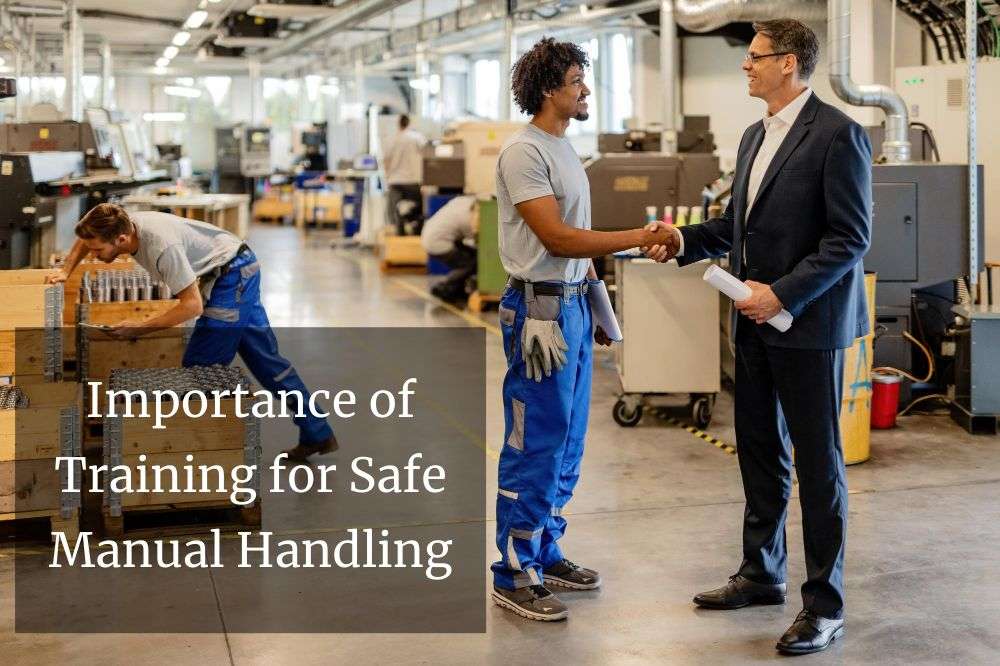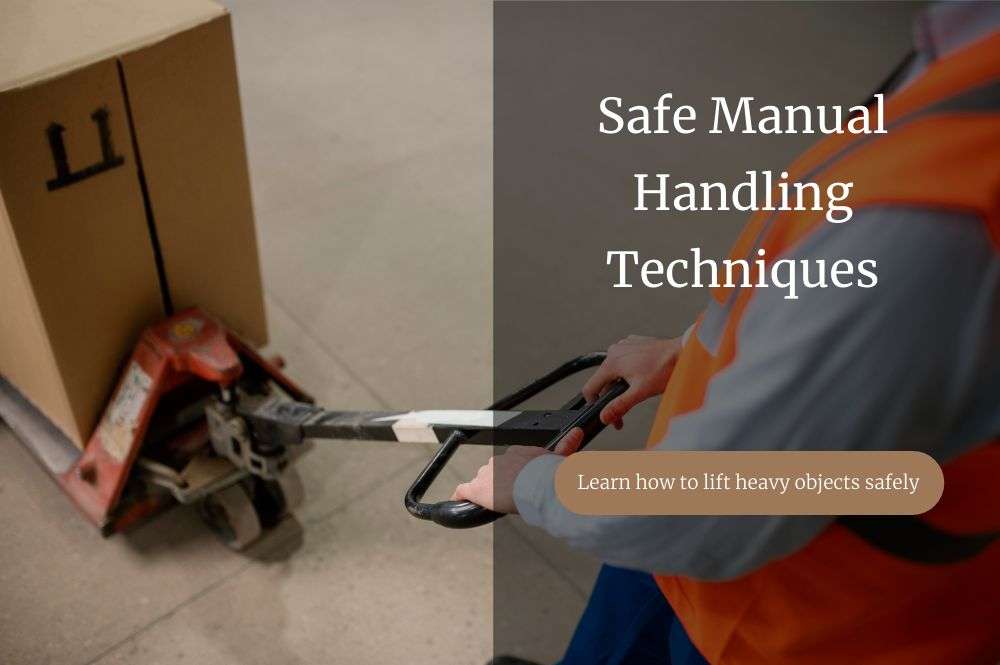In our fast-paced world, where physical tasks are still an integral part of various industries, the importance of safe manual handling cannot be overstated. Whether it’s lifting heavy objects, transporting materials, or performing repetitive motions, improper handling techniques can lead to a range of injuries and musculoskeletal disorders. The repercussions can be debilitating, affecting not only the physical well-being of individuals but also their productivity and overall quality of life.
Overview of Proven Strategies and Effective Techniques
To combat the risks associated with manual handling, a wide array of proven strategies and effective techniques have been developed. These approaches aim to minimize the likelihood of accidents and injuries, promoting a safe working environment for everyone involved. By implementing these strategies, individuals can mitigate the potential harm caused by physical exertion and significantly reduce the incidence of musculoskeletal disorders.
Now, let’s delve into some of the key strategies and techniques that have been proven to enhance the safety of manual handling tasks, ensuring the well-being of workers and optimizing operational efficiency.
A.Ergonomics: Designing for Safety and Efficiency
Ergonomics, the science of designing tasks and equipment to fit the capabilities of individuals, plays a pivotal role in promoting safe manual handling. By considering factors such as posture, biomechanics, and the interaction between workers and their environment, ergonomic principles can be applied to minimize physical strain and maximize efficiency. This approach involves creating workstations and tools that align with the natural movements and capabilities of individuals, reducing the risk of injuries caused by awkward postures or excessive exertion.
B.Training and Education: Empowering Individuals with Knowledge
One of the most effective ways to ensure safe manual handling is through comprehensive training and education programs. By equipping workers with the knowledge of proper lifting techniques, body mechanics, and risk assessment, they can make informed decisions and take necessary precautions when performing physically demanding tasks. Training programs also focus on raising awareness about the potential hazards associated with manual handling, encouraging individuals to proactively identify and address potential risks in their work environment.
C.Mechanical Aids and Assistive Devices: Reducing Physical Strain
The advancement of technology has led to the development of various mechanical aids and assistive devices that significantly reduce the physical strain associated with manual handling. Equipment such as lifting devices, conveyors, and hoists can help lift heavy objects or move materials with minimal effort, minimizing the risk of strains, sprains, and other related injuries. By incorporating these tools into the workplace, organizations can enhance both the safety and efficiency of manual handling tasks.
D.Job Rotation and Task Variation: Balancing Workload
Monotonous, repetitive tasks can increase the likelihood of overuse injuries and fatigue. Job rotation and task variation strategies aim to alleviate these risks by periodically changing the nature of work assigned to individuals. By diversifying the tasks performed, different muscle groups can be engaged, reducing the strain on specific body parts and preventing the development of cumulative trauma disorders. Job rotation also contributes to the overall job satisfaction and engagement of workers.
E.Risk Assessment and Management: Identifying and Mitigating Hazards
Prioritizing risk assessment and management is a crucial element of promoting safe manual handling. This involves conducting thorough evaluations of the workplace to identify potential hazards and implementing appropriate control measures to mitigate the associated risks. By proactively addressing ergonomic issues, providing adequate personal protective equipment, and establishing clear protocols for manual handling, organizations can create a safer work environment for their employees.
By implementing these strategies and techniques, individuals and organizations can significantly reduce the occurrence of manual handling injuries and promote a culture of safety. Remember, safe manual handling not only protects the physical well-being of workers but also contributes to increased productivity, job satisfaction, and overall success in various industries.
Understanding Manual Handling Risks
A.Definition and Scope of Manual Handling
Manual handling encompasses a broad range of activities that involve the use of physical effort to lift, lower, push, pull, carry, or otherwise move objects or people. It is a fundamental aspect of many industries, including manufacturing, construction, healthcare, warehousing, and transportation. From lifting heavy boxes to transferring patients, manual handling tasks can be found in various work environments.
B.Common Hazards and Risks Involved
Engaging in manual handling tasks exposes individuals to a multitude of hazards and risks that can lead to injuries and musculoskeletal disorders.
Some common hazards include:
- Heavy Loads: Lifting or moving heavy objects without proper assistance or equipment can strain the muscles and cause sprains, strains, or even fractures.
- Awkward Postures: Adopting awkward or unnatural postures while performing manual handling tasks can lead to muscle imbalances, back injuries, and joint problems. Bending, twisting, or reaching excessively can put excessive strain on the spine and other vulnerable body parts.
- Repetitive Motions: Performing the same movements repeatedly, such as lifting or carrying objects, can cause overuse injuries, such as tendonitis or bursitis. The repetitive nature of these tasks can lead to cumulative trauma disorders over time.
- Insufficient Rest and Recovery: Inadequate rest breaks and failure to allow the body to recover after physically demanding tasks can increase the risk of fatigue-related injuries. Fatigue impairs muscle coordination, reducing the ability to maintain proper form and increasing the likelihood of accidents.
- Environmental Factors: Factors like slippery floors, poor lighting, or restricted spaces can contribute to accidents during manual handling tasks. Uneven surfaces or obstacles in the work area can increase the risk of trips, slips, and falls, leading to various injuries.
Read more about the Different types risk associated with Manual Handling Here.
C.Consequences of Poor Manual Handling Practices
Poor manual handling practices can have severe consequences for individuals and organizations alike.
Some of the consequences include:
- Musculoskeletal Disorders (MSDs): Improper manual handling techniques can result in the development of musculoskeletal disorders, such as back pain, herniated discs, carpal tunnel syndrome, and tendinitis. These conditions can cause chronic pain, limit mobility, and reduce overall quality of life.
- Decreased Work Efficiency: Injuries caused by manual handling can lead to decreased work efficiency and productivity. Employees who are in pain or physically restricted may not be able to perform their duties effectively, leading to delays, errors, and decreased output.
- Increased Absenteeism and Healthcare Costs: Manual handling injuries often result in absenteeism as individuals require time off to recover. Additionally, organizations may incur significant healthcare costs related to medical treatments, rehabilitation, and disability compensation.
- Psychological Impact: Sustaining a manual handling injury can have psychological effects on individuals, leading to stress, anxiety, and depression. The loss of physical function and independence can significantly impact mental well-being and overall job satisfaction.
- Legal and Regulatory Consequences: Organizations that fail to prioritize safe manual handling practices may face legal consequences. Occupational health and safety regulations require employers to provide a safe working environment and can impose penalties or fines for non-compliance.
Understanding the risks associated with manual handling is crucial for developing effective strategies and implementing preventive measures. By identifying and addressing these hazards, individuals and organizations can significantly reduce the occurrence of injuries, improve workplace safety, and promote the well-being of workers.
Ergonomics and Body Mechanics
A.Exploring Proper Body Mechanics
Proper body mechanics form the foundation of safe manual handling. Understanding and implementing correct body mechanics can significantly reduce the risk of injuries and musculoskeletal disorders.
Here are some key principles to consider:
- Maintaining a Neutral Spine: When lifting or moving objects, it is crucial to maintain a neutral spine position. This means keeping the natural curves of the spine intact and avoiding excessive rounding or arching. Proper alignment of the spine distributes forces evenly and minimizes stress on the back.
- Engaging the Core Muscles: Activating the core muscles, including the abdominal and back muscles, provides stability and support to the spine during manual handling tasks. These muscles act as natural braces, helping to prevent excessive strain on the back.
- Using the Legs: The legs are the powerhouse for lifting and carrying tasks. Bending at the knees, rather than the waist, allows the large muscles of the legs to generate the lifting force. This technique reduces the strain on the back and promotes a more balanced distribution of weight.
- Avoiding Twisting Motions: Twisting while lifting or carrying heavy objects places significant stress on the spine and increases the risk of injury. Instead, it is important to pivot the entire body, keeping the feet pointed in the direction of movement.
B.Ergonomic Considerations for Safe Manual Handling
Ergonomics plays a vital role in promoting safe manual handling practices. By considering ergonomic principles, organizations can design workstations and tasks that minimize physical strain and maximize efficiency.
Here are some important ergonomic considerations:
- Workstation Design: Designing workstations that accommodate the natural range of motion and body dimensions of individuals is essential. Adjustable work surfaces, chairs, and equipment can be tailored to fit different users, reducing the need for awkward postures or excessive reaching.
- Tools and Equipment: Selecting appropriate tools and equipment can greatly facilitate safe manual handling. For example, using handles or grips with sufficient padding and a non-slip surface can improve grip strength and reduce the risk of dropping objects. Ergonomically designed lifting devices and assistive tools can also alleviate the physical strain associated with heavy lifting tasks.
- Clear Pathways and Adequate Space: Ensuring clear pathways and sufficient space in the work environment allows individuals to maneuver and handle objects without obstructions. Cluttered or cramped spaces can force workers into awkward postures and increase the risk of accidents.
- Weight Distribution and Load Management: Proper weight distribution and load management are critical for safe manual handling. Distributing the weight evenly across the body or using equipment like dollies or carts to transport heavy loads reduces the strain on specific body parts and decreases the risk of overexertion.
C.Aligning Posture and Movement Techniques
Achieving proper alignment of posture and movement techniques is essential for safe manual handling.
Consider the following techniques:
- Avoiding Overreaching: When reaching for objects, it is important to avoid excessive stretching or overreaching. Keeping items within a comfortable reach zone reduces the strain on the upper body and minimizes the risk of injury.
- Two-Person Lifts: For particularly heavy or bulky items, utilizing a two-person lift technique is recommended. This allows for the distribution of weight and coordination between individuals, reducing the risk of injury and ensuring better control over the load.
- Pushing and Pulling: Pushing objects is generally less straining on the body than pulling. When pushing, individuals should maintain a straight posture, engage their core muscles, and use their body weight to generate force. Pushing from the lower body instead of the upper body can help prevent back injuries.
- Using Handles and Grips: When lifting or carrying objects, utilizing handles or grips designed forergonomic purposes can enhance grip strength and control. These specialized handles distribute forces more evenly across the hands and fingers, reducing the strain on specific muscles and joints.
By incorporating proper body mechanics, ergonomic considerations, and aligning posture and movement techniques, individuals can significantly reduce the risk of injuries associated with manual handling tasks. These principles promote a safer work environment, enhance efficiency, and contribute to the overall well-being of workers. Remember, implementing these techniques requires continuous practice, awareness, and a commitment to prioritizing safety in every manual handling activity.
Risk Assessment and Planning
A.Conducting a Comprehensive Risk Assessment
Conducting a comprehensive risk assessment is a critical step in ensuring safe manual handling practices. This process involves identifying potential hazards, evaluating the associated risks, and developing strategies to mitigate them.
Here’s an overview of the steps involved:
- Gather Information: Collect information about the manual handling tasks, including the type of materials being handled, the frequency of the tasks, the weight of the loads, and the environmental conditions. This information provides a foundation for assessing the risks involved.
- Identify Hazards: Identify potential hazards that can contribute to injuries or musculoskeletal disorders. This includes examining factors such as heavy loads, awkward postures, repetitive motions, inadequate equipment, environmental obstacles, and insufficient rest periods.
- Assess Risks: Evaluate the likelihood and severity of the identified hazards. Consider factors such as the frequency of exposure, the consequences of potential incidents, and the vulnerability of the workers involved. This risk assessment helps prioritize control measures based on the level of risk associated with each hazard.
- Involve Workers: Engage workers in the risk assessment process since they possess valuable insights into the manual handling tasks they perform. Their experiences and observations can provide valuable input for identifying hazards and assessing risks accurately.
B.Identifying Potential Hazards and Challenges
Identifying potential hazards and challenges specific to manual handling tasks is crucial for effective risk management.
Here are some common areas to consider:
- Load Characteristics: Assess the weight, size, and shape of the objects being handled. Bulky or heavy loads can increase the risk of strains and sprains, while irregularly shaped items can make it challenging to maintain proper grip and control.
- Environmental Factors: Evaluate the work environment for factors that can contribute to accidents or injuries. This includes slippery or uneven surfaces, limited space for maneuvering, poor lighting, and the presence of obstacles or tripping hazards.
- Work Organization: Consider how manual handling tasks are organized within the workplace. Factors such as high workloads, tight deadlines, inadequate staffing, and lack of training can contribute to rushed or improper handling techniques, increasing the risk of injuries.
- Individual Factors: Take into account individual factors such as physical capabilities, experience, and existing health conditions. Workers with pre-existing injuries, limited strength or flexibility, or insufficient training may be more susceptible to injuries during manual handling tasks.
C.Developing a Safe Handling Plan
Based on the information gathered from the risk assessment, it is crucial to develop a safe handling plan to minimize the identified risks.
The plan should include:
- Control Measures: Implement control measures that address the identified hazards. This may involve providing ergonomic equipment, ensuring proper training and supervision, establishing clear protocols for lifting and handling techniques, and implementing engineering controls to reduce physical exertion.
- Training and Education: Provide comprehensive training and education programs to equip workers with the knowledge and skills necessary for safe manual handling. This includes teaching proper lifting techniques, raising awareness about potential hazards, and promoting a culture of safety within the organization.
- Personal Protective Equipment (PPE): Assess the need for personal protective equipment, such as back belts, gloves, or safety shoes, and ensure that workers have access to and are trained in their proper use.
- Monitoring and Review: Regularly monitor the effectiveness of the implemented control measures and revise the safe handling plan as needed. Encourage workers to provide feedback on the plan’s efficacy and address any new hazards or challenges that arise.
By conducting a comprehensive risk assessment, identifying potential hazards and challenges, and developing a safe handling plan, organizations can proactively mitigate the risks associated with manual handling. This systematic approach promotes a safer work environment, reduces the likelihood of injuries, and fosters a culture of continuous improvement in manual handling practices.
Training and Education
A.Importance of Training for Safe Manual Handling
Training is of paramount importance in promoting safe manual handling practices. It equips individuals with the knowledge, skills, and awareness necessary to perform manual handling tasks in a safe and efficient manner.

Here are some reasons why training is crucial:
- Injury Prevention: Proper training empowers individuals to understand the risks associated with manual handling and teaches them techniques to mitigate those risks. By learning correct lifting, carrying, and movement techniques, workers can significantly reduce the likelihood of injuries such as strains, sprains, and musculoskeletal disorders.
- Awareness of Hazards: Training programs raise awareness about potential hazards and challenges specific to manual handling tasks. Workers learn to identify environmental factors, load characteristics, and other elements that can contribute to accidents or injuries. This knowledge enables them to proactively assess risks and take necessary precautions.
- Skill Development: Training enhances the skills required for safe manual handling. It teaches individuals how to use equipment effectively, maintain proper body mechanics, and make informed decisions during physically demanding tasks. By developing these skills, workers can optimize efficiency, minimize physical strain, and promote overall well-being.
- Compliance with Regulations: Occupational health and safety regulations often require employers to provide training on safe manual handling practices. Compliance with these regulations not only ensures a safe working environment but also protects organizations from potential legal and financial consequences.
Looking for Online Manual Handling Certification Training? Enroll it here.
B.Key Elements of Effective Training Programs
Effective training programs should incorporate key elements to maximize their impact.
Here are some essential components:
- Comprehensive Content: Training programs should cover a wide range of topics, including the importance of safe manual handling, hazard identification, risk assessment, proper lifting techniques, body mechanics, and the proper use of equipment. The content should be tailored to the specific needs and tasks of the workforce.
- Practical Demonstrations: Hands-on demonstrations and practical exercises are crucial for translating theoretical knowledge into practical skills. Trainees should have the opportunity to practice proper lifting techniques, use of equipment, and apply ergonomic principles under the guidance of experienced instructors.
- Interactive Learning: Engaging trainees through interactive learning methods enhances their understanding and retention of the material. Incorporating group discussions, case studies, quizzes, and simulations encourages active participation, promotes critical thinking, and reinforces key concepts.
- Train-the-Trainer Approach: To ensure the sustainability of training efforts, organizations can adopt a train-the-trainer approach. This involves training designated individuals within the organization to become trainers themselves. These trainers can then deliver ongoing training sessions, facilitate refresher courses, and provide continuous support to their colleagues.
C.Ensuring Continuous Education and Skill Development
Continuous education and skill development are essential to maintain a high standard of safe manual handling practices.
Here are some strategies to ensure ongoing learning:
- Refresher Training: Conduct periodic refresher training sessions to reinforce knowledge, refresh skills, and update workers on any changes in best practices or regulations. Refresher training serves as a reminder of proper techniques and helps prevent complacency.
- Communication and Feedback: Establish channels for open communication and encourage workers to provide feedback on their experiences and challenges related to manual handling. This feedback can inform the development of targeted training initiatives and address specific needs or concerns.
- Promote a Learning Culture: Foster a culture of continuous learning and improvement by encouraging workers to actively seek out educational resources, attend workshops or seminars, and participate in discussions or forums related to safe manual handling practices. Organizations can also provide access to online resources, articles, and videos to support individual learning.
- Integration with Performance Management: Integrate safe manual handling practices into performance management systems. Recognize and reward individuals who consistently demonstrate safe handling techniques, and provide constructive feedback and coaching to address areas that need improvement.
By prioritizing training and education, organizations can empower their workforcewith the knowledge and skills necessary for safe manual handling. Continuous education and skill development foster a culture of safety, enhance awareness of hazards, and promote the adoption of best practices. Ultimately, investing in comprehensive training programs and ensuring ongoing learning contributes to a safer work environment, reduces the incidence of injuries, and improves overall operational efficiency.
Effective Techniques for Safe Manual Handling
A.Lifting and Carrying Techniques
Proper lifting and carrying techniques are essential for minimizing the risk of injuries during manual handling tasks.
Here are some effective techniques to consider:
- Assess the Load: Before lifting, assess the weight and size of the load. Determine if it can be safely lifted by one person or if assistance is needed. For heavier loads, consider using mechanical aids or team lifting.
- Position Yourself: Stand close to the load with your feet shoulder-width apart for stability. Position yourself in front of the load, maintaining a neutral spine and bending at the knees.
- Get a Good Grip: Ensure a secure grip on the object using the whole hand and fingers. Avoid gripping with only the fingers or fingertips, as this can increase the strain on the hand and increase the risk of dropping the load.
- Lift with Your Legs: Engage your leg muscles to generate the lifting force, keeping the back straight. Push through the legs while maintaining a controlled, smooth motion to lift the load.
- Hold the Load Close: Keep the load close to your body, hugging it against your torso. This minimizes the strain on the back and provides better control over the load.
- Avoid Twisting: When carrying a load, avoid twisting or rotating the spine. Instead, pivot the entire body by moving the feet and keeping the upper body aligned with the direction of movement.
B.Pushing and Pulling Methods
Pushing and pulling techniques can help minimize strain on the body while moving objects.
Consider the following strategies:
- Push Whenever Possible: Pushing is generally preferred over pulling, as it allows you to use your body weight and larger leg muscles. Stand close to the object, bend your knees, and use your body weight to exert force while maintaining a stable posture.
- Maintain Proper Posture: Keep your back straight and your core muscles engaged while pushing or pulling. Avoid excessive leaning or bending at the waist, as this can strain the lower back.
- Use Handles or Grips: Whenever available, use handles or grips designed for pushing or pulling. These provide better control and reduce the strain on the hands and wrists.
- Smooth and Controlled Movements: Maintain a smooth and controlled motion while pushing or pulling. Avoid sudden jerks or quick accelerations, as they can increase the risk of losing control and causing accidents.
- Seek Assistance for Heavy Loads: If the load is too heavy or cumbersome to push or pull safely on your own, seek assistance from a coworker. Teamwork can distribute the effort, enhance control, and reduce the risk of strain or injury.
C.Teamwork and Communication Strategies
Effective teamwork and communication are vital during manual handling tasks, especially when working with others.
Here are some strategies to promote coordination and collaboration:
- Establish Clear Roles: Clearly define the roles and responsibilities of each team member involved in the manual handling task. This ensures that everyone understands their specific duties and can contribute to the task effectively.
- Communicate and Coordinate: Maintain open lines of communication throughout the process. Use verbal cues, hand signals, or designated communication methods to coordinate movements, signal readiness, and indicate changes in direction or pace.
- Work in Sync: Coordinate movements with your team members, ensuring that lifting, carrying, pushing, or pulling actions are synchronized. This minimizes the risk of accidental collisions, enhances control, and promotes efficient teamwork.
- Use Assisting Techniques: When lifting or moving heavy loads as a team, consider using techniques such as the two-person lift or utilizing lifting straps or harnesses for better coordination and load distribution.
- Regular Training and Practice: Conduct regular team training sessions and practice drills to improve coordination, familiarize team members with each other’s capabilitiesand strengths, and reinforce effective teamwork and communication strategies.
By implementing these effective techniques for safe manual handling, individuals and teams can minimize the risk of injuries, enhance control and efficiency, and promote a culture of safety in the workplace. Remember, continuous training, practice, and open communication are key to ensuring the successful implementation of these techniques and maintaining a safe working environment.
Equipment and Tools for Safe Handling
A.Assistive Devices and Equipment
Assistive devices and equipment play a crucial role in promoting safe manual handling practices. These tools are designed to reduce physical strain, enhance control, and minimize the risk of injuries.
Here’s an introduction to some commonly used assistive devices and equipment:
- Lifting Aids: Lifting aids include equipment such as lifting slings, hoists, and mechanical lifters. These devices assist in lifting and moving heavy or bulky loads, reducing the strain on the body and minimizing the risk of overexertion.
- Conveyors and Conveyor Belts: Conveyors and conveyor belts are used to transport materials or objects efficiently within a workplace. They eliminate the need for manual carrying and reduce the risk of strains or injuries associated with repetitive lifting and carrying tasks.
- Hand Trucks and Dollies: Hand trucks and dollies are wheeled devices designed to transport heavy loads. They provide a stable platform for loading objects and distribute the weight more evenly, reducing the physical strain on individuals.
- Ergonomic Handles and Grips: Ergonomic handles and grips are designed to provide a comfortable and secure grip on objects. These handles are often padded and contoured to fit the natural shape of the hand, reducing the strain on the fingers and improving control during handling tasks.
B.Proper Selection and Use of Handling Aids
Proper selection and use of handling aids are crucial for maximizing their effectiveness and ensuring safe manual handling.
Consider the following guidelines:
- Assess Task Requirements: Evaluate the specific requirements of the manual handling task to determine the most suitable handling aid. Consider factors such as load weight, size, shape, and the environment in which the task will be performed.
- Training and Familiarization: Provide proper training and familiarization sessions for individuals who will be using the handling aids. This ensures that they understand how to operate the equipment correctly, including any safety features and precautions.
- Consider Ergonomics: Select handling aids that have ergonomic features, such as adjustable heights, comfortable handles, and controls positioned for easy reach. Ergonomic design reduces the risk of strain or discomfort during prolonged use.
- Follow Manufacturer’s Instructions: Adhere to the manufacturer’s guidelines and instructions for the proper use of handling aids. This includes load capacity limits, maintenance requirements, and any specific operating procedures.
- Inspect and Maintain: Regularly inspect handling aids to ensure they are in good working condition. Check for any damage, wear and tear, or malfunctioning parts. Perform routine maintenance as recommended by the manufacturer.
C.Maintenance and Inspection of Equipment
Proper maintenance and inspection of equipment are essential for ensuring the longevity and reliability of handling aids.
Here are some key considerations:
- Regular Inspections: Conduct regular inspections of handling aids to identify any signs of damage, wear, or malfunctions. Inspect components, such as wheels, frames, handles, and control mechanisms, to ensure they are functioning properly.
- Repair or Replace Damaged Parts: Promptly address any identified issues by repairing or replacing damaged parts. Do not use handling aids with damaged components, as it can compromise safety and lead to accidents or injuries.
- Lubrication and Cleaning: Follow the manufacturer’s recommendations for lubrication and cleaning. Keep the equipment clean and free from debris or obstructions that may hinder its functionality.
- Calibration and Adjustment: Some handling aids, such as lifting devices or hoists, may require periodic calibration or adjustment to maintain their accuracy and performance. Refer to the manufacturer’s instructions or consult with a qualified technician for these procedures.
- Staff Training: Train designated staff members to conduct routine maintenance tasks and inspections. Ensure they understand the importance of proper equipment care and are familiar with the specific maintenancerequirements of each handling aid.
By introducing and utilizing assistive devices and equipment, selecting them appropriately, and maintaining them regularly, organizations can enhance the safety and efficiency of manual handling tasks. These tools reduce physical strain, improve control, and minimize the risk of injuries. Remember, proper training, adherence to manufacturer guidelines, and regular maintenance are key to ensuring the effective and safe use of handling aids.
Creating a Culture of Safety
A.Promoting Safety Awareness and Responsibility
Creating a culture of safety is crucial for maintaining a safe work environment and promoting the well-being of individuals involved in manual handling tasks.
Here are some strategies to promote safety awareness and responsibility:
- Leadership Commitment: Leadership should demonstrate a strong commitment to safety by establishing clear expectations, providing necessary resources, and leading by example. When leaders prioritize safety, it sets the tone for the entire organization.
- Safety Training and Education: Provide comprehensive training and education programs on safe manual handling practices. Ensure that all employees, including new hires, receive proper training and have a clear understanding of their responsibilities in maintaining a safe workplace.
- Regular Safety Meetings: Conduct regular safety meetings to discuss best practices, share experiences, and address any safety concerns or issues. These meetings provide a platform for open communication and ensure that safety remains a top priority.
- Safety Policies and Procedures: Develop and communicate clear safety policies and procedures related to manual handling tasks. These guidelines should outline expectations, hazard identification and control measures, reporting mechanisms, and consequences for non-compliance.
B.Encouraging Reporting and Feedback Mechanisms
Encouraging reporting and feedback mechanisms is crucial for identifying and addressing safety concerns in a timely manner.
Consider the following strategies:
- Anonymous Reporting: Establish anonymous reporting mechanisms to encourage individuals to report safety hazards, near misses, or incidents without fear of retribution. This allows for honest and open reporting, ensuring that potential risks are addressed promptly.
- Regular Safety Audits: Conduct regular safety audits or inspections to identify any potential hazards or areas for improvement. Encourage employees to actively participate in these audits and provide input on safety issues they observe.
- Open Communication Channels: Foster a culture of open communication where employees feel comfortable reporting safety concerns or providing feedback. Implement an open-door policy, suggestion boxes, or digital platforms where individuals can share their insights and suggestions for improving safety practices.
- Prompt Investigation and Action: Respond promptly to reported safety concerns, investigate incidents or near misses thoroughly, and take appropriate actions to address identified issues. Communicate the actions taken to employees to demonstrate the organization’s commitment to their safety.
C.Continuous Improvement and Evaluation
Continuous improvement and evaluation are key elements in creating a culture of safety.
Here are some strategies to promote ongoing improvement:
- Regular Evaluation: Continuously assess the effectiveness of safety measures and practices related to manual handling. This can be done through safety performance indicators, incident and near-miss analysis, and feedback from employees. Regularly review and update safety policies and procedures based on the evaluation findings.
- Learning from Incidents: Use incidents and near misses as learning opportunities. Conduct thorough investigations to identify root causes and implement corrective actions to prevent similar incidents from occurring in the future. Share lessons learned with employees to enhance safety awareness and knowledge.
- Training and Skill Development: Provide ongoing training and skill development opportunities for employees to enhance their understanding of safe manual handling practices. Offer refresher courses, workshops, or seminars to reinforce knowledge and promote continuous skill development.
- Recognition and Rewards: Recognize and reward individuals or teams that actively contribute to maintaining a safe working environment. Acknowledge those who demonstrate exemplary safety practices, report hazards, or suggest improvements. Celebrating achievements reinforces the importance of safety and motivates others to follow suit.
By promoting safety awareness and responsibility, encouraging reporting and feedback, and prioritizing continuous improvement and evaluation, organizations can foster a culture of safety. This culture creates an environment where individuals are empowered to prioritize safety, take ownership of their actions, and work together towards the common goal of maintaining a safe and healthy workplace for all.

Conclusion
Safe manual handling is of paramount importance in every industry and workplace. It not only protects individuals from injuries and musculoskeletal disorders but also improves overall productivity, efficiency, and employee well-being. By implementing the strategies and techniques discussed, organizations can create a safer work environment, reduce healthcare costs, enhance job satisfaction, and comply with legal and regulatory requirements.
In conclusion, safe manual handling is a shared responsibility that requires a multifaceted approach. By implementing the proven strategies and effective techniques discussed here, organizations can protect their employees, improve operational efficiency, and create a culture where safety is valued above all else. Let us prioritize safe manual handling practices and work towards a safer and healthier future for all.
Frequently Asked Questions (FAQs)
What are the risks associated with improper manual handling?
Improper manual handling poses various risks, including musculoskeletal injuries, strains, sprains, and back pain. It can also lead to long-term health issues such as repetitive strain injuries and chronic pain. Understanding these risks is crucial for implementing safe manual handling practices and preventing workplace injuries.
How can proper body mechanics improve manual handling safety?
Proper body mechanics, such as maintaining a neutral spine, engaging core muscles, and using the legs for lifting, reduce the strain on the body during manual handling tasks. By adopting these techniques, individuals can distribute the load more evenly, minimize the risk of injury, and promote overall safety and well-being.
How can organizations promote a culture of safety in manual handling?
Promoting a culture of safety in manual handling requires leadership commitment, comprehensive training programs, open communication channels, and continuous evaluation. When leaders prioritize safety, provide training, encourage reporting of safety concerns, and regularly assess the effectiveness of safety measures, it fosters a culture where safety becomes a shared responsibility and is integrated into daily operations.
What are some effective tools and equipment for safe manual handling?
There are various tools and equipment available to enhance safe manual handling. Lifting aids such as hoists and mechanical lifters can reduce physical strain when moving heavy loads. Hand trucks, dollies, and conveyors provide stability and ease when transporting objects. Ergonomic handles and grips improve grip strength and control. Selecting the right tools for specific tasks enhances safety and efficiency.
Why is risk assessment important in manual handling tasks?
Risk assessment is crucial in manual handling tasks as it helps identify potential hazards and evaluate the associated risks. By conducting a comprehensive risk assessment, organizations can prioritize control measures, develop safe handling plans, and minimize the likelihood of injuries. It enables proactive measures to be taken to create a safer work environment and protect the well-being of employees.
How can teamwork and communication contribute to safe manual handling?
Teamwork and communication are integral to safe manual handling. By establishing clear roles and responsibilities, coordinating movements, and using effective communication strategies, individuals can work together more efficiently and reduce the risk of accidents or injuries. Teamwork promotes better control, enhances situational awareness, and fosters a collaborative approach to ensuring safety in manual handling tasks.












